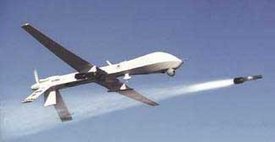 |
| Hellfire missile from drone fired by remote control in Nevada |
David S. Cloud
Common Dreams
Nearly three miles above the rugged hills of central Afghanistan, American eyes silently tracked two SUVs and a pickup truck as they snaked down a dirt road in the pre-dawn darkness.
The vehicles, packed with people, were 3 1/2 miles from a dozen U.S. special operations soldiers, who had been dropped into the area hours earlier to root out insurgents. The convoy was closing in on them.
At 6:15 a.m., just before the sun crested the mountains, the convoy halted.
“We have 18 pax [passengers] dismounted and spreading out at this time,” an Air Force pilot said from a cramped control room at Creech Air Force Base in Nevada, 7,000 miles away. He was flying a Predator drone remotely using a joystick, watching its live video transmissions from the Afghan sky and radioing his crew and the unit on the ground.
The Afghans unfolded what looked like blankets and kneeled. “They’re praying. They are praying,” said the Predator’s camera operator, seated near the pilot.
By now, the Predator crew was sure that the men were Taliban. “This is definitely it, this is their force,” the cameraman said. “Praying? I mean, seriously, that’s what they do.”
“They’re gonna do something nefarious,” the crew’s intelligence coordinator chimed in.
At 6:22 a.m., the drone pilot radioed an update: “All … are finishing up praying and rallying up near all three vehicles at this time.”
The camera operator watched the men climb back into the vehicles.
“Oh, sweet target,” he said.
—
None of those Afghans was an insurgent. They were men, women and children going about their business, unaware that a unit of U.S. soldiers was just a few miles away, and that teams of U.S. military pilots, camera operators and video screeners had taken them for a group of Taliban fighters.
The Americans were using some of the most sophisticated tools in the history of war, technological marvels of surveillance and intelligence gathering that allowed them to see into once-inaccessible corners of the battlefield. But the high-tech wizardry would fail in its most elemental purpose: to tell the difference between friend and foe.
This is the story of that episode. It is based on hundreds of pages of previously unreleased military documents, including transcripts of cockpit and radio conversations obtained through the Freedom of Information Act, the results of two Pentagon investigations and interviews with the officers involved as well as Afghans who were on the ground that day.
The Afghan travelers had set out early on the cold morning of Feb. 21, 2010, from three mountain villages in southern Daikundi province, a remote central region 200 miles southwest of Kabul.
More than two dozen people were wedged into the three vehicles. Many were Hazaras, an ethnic minority that for years has been treated harshly by the Taliban. They included shopkeepers going for supplies, students returning to school, people seeking medical treatment and families with children off to visit relatives. There were several women and as many as four children younger than 6.
They had agreed to meet before dawn for the long drive to High- way 1, the country’s main paved road. From there, some planned to go north to Kabul while others were headed south. To reach the highway, they had to drive through Oruzgan province, an insurgent stronghold.
“We traveled together, so that if one vehicle broke down the others would help,” said Sayed Qudratullah, 30, who was bound for Kabul in hope of obtaining a license to open a pharmacy.
Another passenger, Nasim, an auto mechanic who like many Afghans uses one name, said that he was going to buy tools and parts.
“We weren’t worried when we set out. We were a little scared of the Taliban, but not of government forces,” he said referring to the Afghan national army and its U.S. allies. “Why would they attack us?”
Read Full Article
RELATED ARTICLE:
The Future Expansion of Drones Over The U.S.




Be the first to comment on "American High-Tech Weapons Fail to Prevent Tragedy"